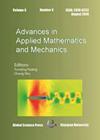Development of a Novel Nonlinear Dynamic Cavitation Model and Its Numerical Validations
IF 1.1
4区 工程技术
Q2 MATHEMATICS, APPLIED
引用次数: 0
Abstract
Aiming at modeling the cavitation bubble cluster, we propose a novel nonlinear dynamic cavitation model (NDCM) considering the second derivative term in Rayleigh-Plesset equation through strict mathematical derivation. There are two improvements of the new model: i) the empirical coefficients are eliminated by introduction of the nonuniform potential functions of $\psi_v$ and $\psi_c$ for growth and collapse processes respectively, and ii) only two model parameters are required, which both base on physical quantities–the Blake critical radius $R_b$ and the average maximum growth radius $R_m.$ The corresponding cavitation solver was developed by using OpenFOAM in which we implemented the modified momentum interpolation (MMI) method to ensure that the calculated results are independent of time step size. Three validation cases, namely numerical bubble cluster collapse, ultrasonic horn experiment, and hydrodynamic cavitation around slender body are employed. The results indicate that $\psi_v$ and $\psi_c$ can reveal the nonlinear characteristics for cavity accurately, and $R_b$ and $R_m$ can reflect the relevance between cavitation model and actual physical quantities. Moreover, it is discussed the potentiality of NDCM that is generally applied on the cavitating flow possessing with dispersed bubbly cloud.新型非线性动态气蚀模型的开发及其数值验证
针对空化气泡团的建模问题,我们通过严格的数学推导,提出了一种考虑雷利-普莱塞特方程二阶导数项的新型非线性动态空化模型(NDCM)。新模型有两点改进:i)通过引入分别用于生长和塌陷过程的 $\psi_v$ 和 $\psi_c$ 的非均匀势函数,消除了经验系数;ii)只需要两个模型参数,这两个参数都基于物理量--布莱克临界半径 $R_b$ 和平均最大生长半径 $R_m。我们使用 OpenFOAM 开发了相应的空化求解器,并在其中采用了修正动量插值(MMI)方法,以确保计算结果与时间步长无关。我们采用了三个验证案例,即数值气泡簇坍塌、超声波喇叭实验和细长体周围的流体动力空化。结果表明,$\psi_v$和$\psi_c$能准确揭示空化的非线性特征,$R_b$和$R_m$能反映空化模型与实际物理量的相关性。
本文章由计算机程序翻译,如有差异,请以英文原文为准。
求助全文
约1分钟内获得全文
求助全文
来源期刊

Advances in Applied Mathematics and Mechanics
MATHEMATICS, APPLIED-MECHANICS
CiteScore
2.60
自引率
7.10%
发文量
65
审稿时长
6 months
期刊介绍:
Advances in Applied Mathematics and Mechanics (AAMM) provides a fast communication platform among researchers using mathematics as a tool for solving problems in mechanics and engineering, with particular emphasis in the integration of theory and applications. To cover as wide audiences as possible, abstract or axiomatic mathematics is not encouraged. Innovative numerical analysis, numerical methods, and interdisciplinary applications are particularly welcome.
 求助内容:
求助内容: 应助结果提醒方式:
应助结果提醒方式:


